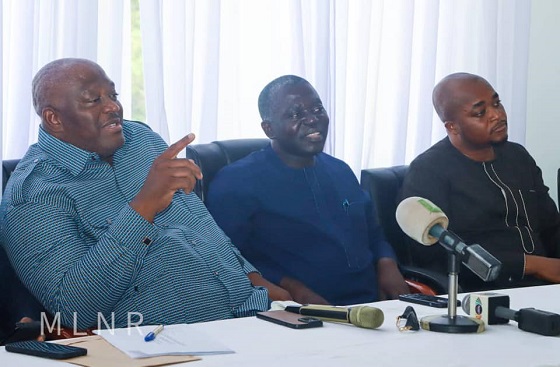The age-old impasse of the Sakumono Ramsar site is on the verge of a peaceful settlement and conclusion, after several efforts by the Ministry of Lands and Natural Resources and the Greater Accra Regional Coordinating Council to rest grievances among involving parties over Land encroachment in the area.
Having been updated on the efforts made by the leading institutions over the period of contemplations to protect the Ramsar Site from further encroachment, all stakeholders have safely arrived at an agreement to allow the Greater Accra Regional Coordinating Council demolish some 136 structures encroaching within the core area of the Sakumono Ramsar site.
Addressing the media after fruitful discussions on the matter, the Deputy Minister for Lands and Natural Resources responsible for Lands and Forestry, Hon. Benito Owusu-Bio said that this demolishing is a necessary evil that needs to be done to serve the greater good of all factions and the entire country, as it will to a great extent help retain Ghana's position as a signatory to the United Nation’s convention on protecting forests and Ramsar sites.
He also alluded to recent flood reports from other parts of the world and even Ghana saying that if care is not taken and the demolish exercise not done as soon as practicable, bigger floods will soon swallow the cities, implicating innocent Ghanaian home owners.
Hon. Benito stressed that these 136 structures to be demolished are not habitable homes, which he explained to mean "uncompleted structures that have no human living in them, fence walls, foundations, quarters of caretakers and similar others"
He asserted that to ensure an all-inclusive exercise, the demolish will involve representatives of the traditional councils, the encroachers landlord's association, the Forestry Commission.
The Deputy Minister assured that regulation processes will be carried out for unaffected houses but was however quick to add that it may tarry as a lot of work needs to be done with the taking of inventory and ensuring that proper documentations are made for records keeping.
The Greater Accra Regional Minister, Hon. Henry Quartey expressed his joy and relive that such a conclusion has been reached after several years of strive and struggle over the matter.
In the spirit of settling all issues and disputes, the Greater Accra Comando, charged the Technical Director for Lands at the Ministry, Mr. Maxwell Adu-Nsarfoa to as a matter of urgency constitute a committee to bring an end to the boundary issue that exit between the Forestry Commission and Celebrity, a private developer who claims to own parts of the Ramsar site.
He clarified that as the regulation processes commences, only lands with completed houses will be regularized, not bare lands and therefore cautioned "those who will go and buy new lands in the area with the idea that it will be regularized should take hide and refrain from taking such actions".
Hon. Henry Quartey highly applauded the Chiefs of the two Traditional Councils involved in the impasse; the Tema and Nungua Traditional Councils for their patience and continous support throughout discussions and negotiations.
Mr. John Allotey, the CEO of the Forestry Commission, during his turn, gave a detailed presentation on efforts and actions taken by the Lands Ministry and the Commission to protect the Ramsar Site from further encroachment while stating the findings of the Committee set up by the Sector Minister, Hon. Samuel A. Jinapor to settle the matter.
In his presentation, the CEO of the Forestry Commission also brought to light the recommendations of the Committee which he hoped will be adopted to help in processes .
Mr. Allotey who also presented to the house the options available in salvaging the rest of the Ramsar site, presented on the four options weighed by government and after discussions and deliberations, the concurred on option four, which is to reduce the original size of the core area of the Ramsar site to a land space of 8.30km squared.





